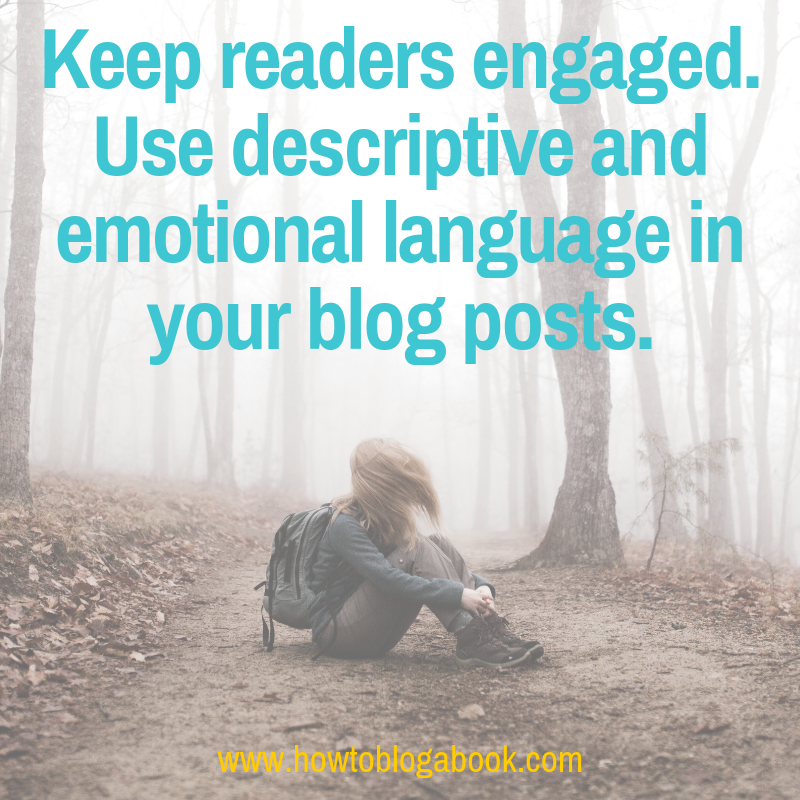
Have you ever heard the writing advice to “show, don’t tell”? Well…it applies to blogging, too. That’s why today, Beth Bauer (@JourneyofBethB), provides some excellent tips on using descriptive and emotional language to engage your readers in posts.
This morning, as I read a blog post about pet care, I went through almost half a box of tissues. I was sobbing as if I had just broken up with my high school sweetheart. Who knew that a simple article about the importance of getting your dog chipped could be so moving?
It was a heartwarming story about a woman that lost her dog, but eventually, they were reunited. She explained the situation in a way that grabbed my attention and touched me deep inside.
There are many ways to engage your audience, such as targeting your content specifically to your readers and using a strong call to action that get them to act. However, the best way to engage your readers and help them remember you—and to share your content—is by using emotional language and vivid descriptions. When people laugh or cry while reading your material, you leave a lasting impression, and that is the most effective way to grow your audience. They will keep coming back for more.
Visualize the Thing(s) You are Writing About
First of all, not every person or thing you write about needs a vivid description. No one wants to read a detailed essay about a ballpoint pen or a typical toilet. But, when writing about things that can have a significant impact, like a sunset, or the first time you ever held your child, emotional language and vivid descriptions can be powerful.
When you think about a sunset, what do you see in your mind? If you’re struggling with visualizing it, look at an actual photo of a sunset, or even better, observe a real one. Notice how the colors interact. What are the shapes of the clouds? How do you feel? Has your breathing changed? Does it remind you of someone? Choose words that describe the textures, shapes, feeling, sounds, and aromas while resisting the urge just to list them. Here is an example.
“As I gently opened my eyes at the sounds of sparrows chirping blissfully outside, I was struck by the brilliant glow of the sun reflecting on the curtains. Curiosity drove me to rush to the big bay window of my bedroom and peek outside, and when I pulled back the soft satiny drapes, I was astonished at the site before me. The sun was beginning to rise over the snowy mountain peaks in the distance and casting the most glorious pink glow across the still sleepy valley below. Soft shades of orange and yellow beckoned the morning, and I began to hum along with the sweet song of the birds perched on the young cedar tree outside my window.”
You may be thinking that the above description is fine for a novel, but a blog might be a little different, right? Wrong. You still have to captivate their imagination and evoke feelings, or readers are going to keep scrolling on to your competition. Sometimes you don’t need a lot of words to make a significant impact.
Think About the Feeling You Want to Arouse
If you want your readers to get angry, choose words that create fear or contempt. If you want them to feel happy, select words that will put them at peace or make them laugh. If they are supposed to feel sad, talk about the tangible feeling of loss, how it’s hard to breathe and get up off the couch.
Show Don’t Tell
One of my mentors once told me that the best way to improve my writing skills was to show, not tell. Don’t just write that it was cold outside. Instead, write about how you could see your breath and how you pulled your hat down over your ears. Mention the icy roads glistening in the early morn sunshine and how the frost sparkled on the trees. Pull your readers into the picture, so that they feel like they’re there along with you.
It might seem difficult at first to expand your vocabulary and use vivid descriptions, but the more you do it, the easier it gets. Use the synonyms finder on your word processor and start using words that are new to you. Also, read the works of other good writers until it starts to feel more natural.
Soon, using emotional language and vivid descriptions will become second nature, and your reward will be a growing an engaged audience and a strong platform.
How do you keep your blogging feeling fresh and your skill level high? Tell me in a comment below.
About the Author
 Beth Bauer is a freelance writer, travel blogger, yoga instructor, and entrepreneur currently working on her third novel. She has traveled to over 20 countries in just the last two years and enjoys life as a digital nomad. She is originally from the Pacific Northwest of the U.S.A., and when she’s home lives on the Long Beach Peninsula with her dog, Ozzie.
Beth Bauer is a freelance writer, travel blogger, yoga instructor, and entrepreneur currently working on her third novel. She has traveled to over 20 countries in just the last two years and enjoys life as a digital nomad. She is originally from the Pacific Northwest of the U.S.A., and when she’s home lives on the Long Beach Peninsula with her dog, Ozzie.
Photo courtesy of Andrew Neel on Unsplash

Leave a Reply